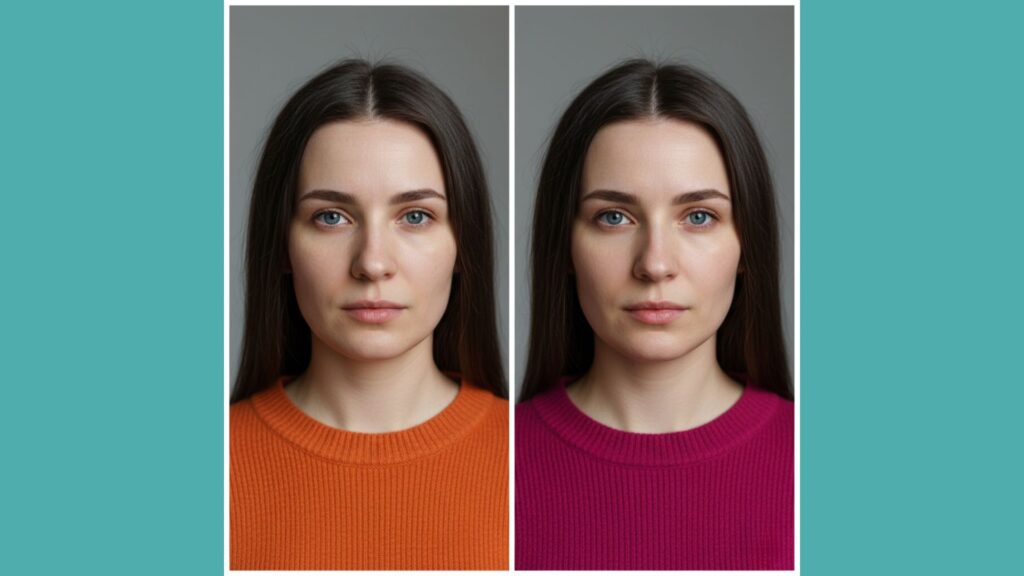Hi everyone!
So you want to figure out your undertone? Great! But fair warning—there’s a lot of misinformation floating around online, and I’m here to set the record straight.
Let’s talk about undertone, what it actually is, and how to find yours without falling for the myths.
Let’s Bust the Myths First (You’ve Probably Heard These)
1. “Check the Color of Your Veins!”
This is the classic advice: “If your veins are blue, you’re cool. If they’re green, you’re warm.”
Nope. That’s just not accurate.
It’s been proven that vein color has nothing to do with undertone. I’ve seen plenty of people with blue veins who are actually warm-toned, and green-veined folks who are cool. Vein color depends on skin thickness, lighting, and blood vessel depth—not your undertone.
2. “Look at Your Eyes / Nails / Lips!”
These “quick fixes” sound appealing, but they’re equally misleading.
Your sclera (the white of your eye) can appear bluish or more ivory for dozens of reasons—fatigue, genetics, age. Your nail beds and lip mucosa? Same story. These features aren’t reliable indicators of undertone.
3. “Your Foundation Shade Tells You Everything”
Here’s the thing: foundation tone is completely different from your undertone.
Foundation (whether it’s yellow, pink, or neutral) is just correcting your overall complexion. Your undertone is about which clothing colors will make you look radiant versus drained. Two totally different things.
So, How Do You Actually Find Your Undertone?
The real answer? You have to see how colors react with your skin.
There’s no shortcut. No test. Just honest color observation.
Here’s the Process:
-
Face completely bare (no makeup)
-
Natural light (or lamps that mimic daylight—around 5500K)
-
Fabric draped near your face (close enough to make a difference, but not touching)
Now, what do you look for?
✅ If a color WORKS for you:
-
Your face stays sharp and defined
-
Your complexion looks even and healthy
-
Dark circles don’t suddenly become prominent
-
Redness doesn’t look inflamed
-
You look… well, like yourself—but elevated
❌ If a color DOESN’T work:
-
Your face looks washed out or gray
-
Your complexion looks yellowish or off
-
Dark circles become pronounced
-
Redness seems exaggerated
-
You look tired or sallow
It sounds simple, but observation skills matter. This is why experience counts.

Wait—Do “Neutral” Undertones Actually Exist?
Short answer: Not really.
There are people who appear very neutral and balanced—and they can pull off a wider range of colors. But they’re usually neutral-warm or neutral-cool. The tendency is always there, even if it’s subtle.
In my Holistic Color System, I analyze people based on dominant characteristics. Here’s what I mean:
When I’m working with someone, I’m looking for their primary characteristic among these three:
-
Temperature (warm/cool)
-
Value (light/dark)
-
Intensity (vibrant/muted)
Let me give you an example:
Say someone’s dominant characteristic is deep value (they need darker colors). Their secondary characteristic might be low intensity (softer, muted tones). And their tertiary? Maybe neutral-cool temperature.
What does that mean in practice? Their colors will be deep, softly saturated, and slightly cool—but beautifully balanced. In this case, undertone exists, but it’s almost like a background note in a perfume. It’s there, but it’s not the main story.
Someone like this could occasionally wear a slightly warm-toned piece and still look great—as long as it respects their primary and secondary characteristics.
When Does Undertone Actually Matter?
For some people, undertone is the dominant characteristic. If you’re intensely warm or intensely cool, it affects everything:
If you’re very cool: Warm colors will make you look yellow and tired.
If you’re very warm: Cool colors will drain you and make you look gray.
But for people with more balanced undertones? Temperature becomes less rigid, and other characteristics take the lead.
Want to Test This at Home?
If you’re curious, grab fabrics from opposite sides of the color wheel and try them:
-
Orange vs. Fuchsia
-
Black vs. Warm Brown
-
Bright White vs. Cream (the yellowish kind)
-
Gold vs. Silver (though this one’s often inconclusive for neutral people)
Hold them near your face in natural light and observe. If one visibly works better than the other, you’ve found a clue. But remember: undertone isn’t the whole picture.
When to Get Professional Help
If you’ve tried this at home and you’re still confused (which is totally normal!), especially if you’re naturally neutral, that’s what professionals are for.
Understanding undertone—really understanding it—takes trained observation, proper lighting, and a range of test fabrics. Sometimes it’s just worth getting it right the first time.
I offer two options:
-
Smart Color Consultation (23 USD): Discover your dominant color characteristic—whether that’s temperature, value, or intensity
-
Complete Color Consultation (110 USD): Get your full personalized palette with all the nuances
Quick Recap:
✅ Vein color = Not a reliable indicator
✅ Eye/nail/lip color = Not reliable
✅ Foundation shade = Not the same as undertone
✅ The real test = How colors make your face look
✅ “Neutral” undertones = Rare, but usually lean slightly warm or cool
✅ Undertone matters most = When it’s your dominant characteristic
If this resonated with you and you want to stop guessing, check out my consultation options to discover your true undertone and start choosing colors that actually work.
Hope this cleared things up! Drop your questions in the comments or hit me up on social media.
Until next time! 💕
